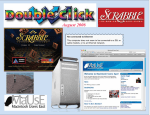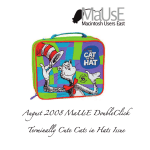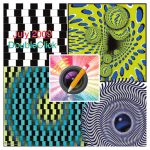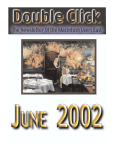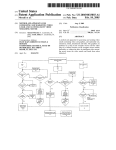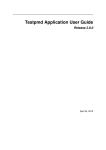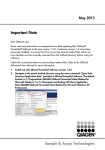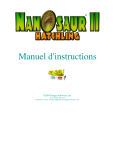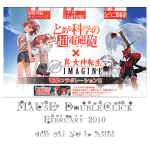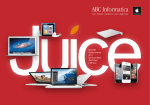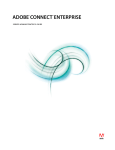Download January 2006
Transcript
January 2006 President Hm: (905) 263-4167 Solina Jim Foster Email: [email protected] Apple Ambassador Hm: (905) 983-9205 Orono Bruce Cameron Email: [email protected] Treasurer Hm: 905-404-0405 Oshawa John Kettle Email : [email protected] Publicity Director and Jolly Good Fellow Jim Danabie Logistics Email: [email protected] C. Greaves Secretary Email: [email protected] Stan Wild Macintosh Users East [MaUsE] eMail: [email protected] 208 Winona Avenue, Oshawa, Ontario, L1G 3H5 Submissions from MaUsE Club members, although rarer than living, breathing mastodons, are always welcome. Send them to me either at: <[email protected]> if they are just text messages or at <[email protected]> if there are files or pictures attached. I have never refused a submission yet. Thereʼs always room for another piece on ANY Mac-related topic and Iʼll make room if there isnʼt. I would like your submissions. But I wonʼt beg. The next meeting will be held at the new Whitby Public Library in Whitby, Ontario, at 7:30 on January 25th, 2006 !!!!!!!! Henry Street New Whitby Public Library Apple, Macintosh, and the Apple logo are trademarks of Apple Computer, Inc., registered in the U.S. and other countries. The MaUsE (Macintosh Users East) is an independent user group and has not been authorized, sponsored, or otherwise approved by Apple Computer, Inc. King Street Free Parking Double Click Double Click on the web at: www.mause.ca Double Click Editor Michael Shaw Hm: (905) 576-2097 Oshawa Email: [email protected] [email protected] [email protected] Notice The MaUsE Meeting in January will be held on the 25th at 7:30 P.M. in Whitby, Ontario, at the New Whitby Public Library on the corner of Henry Street and Dundas Street (Highway #2). Henry Street is four streets west of the four corners in Whitby and FREE parking is available after 6:00 P.M. just south of the nearby Scotia Bank. Be there or be square. (Highway #2) Please feel free to contact any of the following individuals if you have comments or questions relating to Macintosh Users East or Macintosh computing in general. What you are looking at is the January 2006 edition of the Double Click monthly newsletter from the Macintosh Users East, (MaUsE), a motley collection of old and new Mac users who reside in Southern Ontario with a motley collection of old and new Macintosh computers. What more do you need to know ? Oh, yes. This newsletter is created more or less single-handed by Michael Shaw, Double Click Editor, on his Sonnet-powered personal PCI Macs. He uses mostly a G4 Power Macintosh 9600/800 and a pair of antique G4 Daystar Genesis MP 800+ Macintosh clones. The rest of the Double Click support staff are a 450 MHz G3 Power Macintosh B&W tower, and the “new boy,” a white 1 GHz G4 iBook. An digital Kodak DX7590 is used for all pictures. Back issues can be downloaded from the <www.mause.ca> website for a laugh. Scotia Bank Center Street Dundas Street West Executive Contact List SWF to FLA Converter We don’t always receive documents in the format that best suits our purposes, as everyone knows who has ever received a email with a windows Word or Excel document attached. In last month’s Double Click I featured an application called EasyWMA that allows you to convert wma audio files to mp3, m4a or wav format so that you can play your favorite songs in iTunes or any other player on your Mac. There are very few of who with extension .fla. To be viewable can understand how utilities like Easyby someone else online, it must then WMA work but that does not prevent be published to produce a .swf file us from making use of them. Some of (published Flash movie) and .html the most useful and often-used utilities file (in which the swf is embedded). are the ones that can convert a docuThe image below is a screen shot of ment from one format to another more a Flash movie under development. In desirable format. Graphic Converter is it, you can see the timeline panel at probably the most famous, powerful, and most the top, which shows that the movie frequently used “converter” of them all. SWF (fish.fla) contains actionscript (indito FLA Converter is another such utility. It may not be cated by the little ‘a’ in the actions layer), sound of use to everyone with a Mac but what it does it does (beginning in frame 1 of the music layer), and graphic content in the fish1 and fish2 layer. Flash magically and well. can be used to create interactive rich media content For those of us for whom the internet is a spectator sport (including text, photos, music, video, vector graphmerely, this software may be of limited use. For those ics, voiceover, and a wide variety of motion graphic of us who actively create animations on the web or use effects and animation) to be displayed in a browser. Macromedia products to create By producing a compiled Flash movie and an html multimedia presentations for page which embeds that movie and uploading both education or entertainment pur- to a web server, the content is made viewable to a poses SWF to FLA Converter site visitor via a Flash browser plug-in, is a real treasure. There will be one or two copies of this utility SWF to FLA Converter for Mac OS converts Macavailable for the January MaUsE romedia Shockwave Flash file format (SWF) files back raffle, (members only) donated into FLA format in one click. It offers a number of by Eltima Software for our en- unique algorithms to extract all Flash objects from SWF joyment. file and store them in a FLA file, which can be edited in native Flash environment. Every group of objects such Animation within a Flash as morphs, shapes, texts, fonts, motions, sounds, Acmovie is achieved by using tionScripts, etc. could be placed in separate FLA library a series of frames and key- groups, which makes using and viewing the resulting frames, each with its own FLA file much easier. Additionally, you may customize graphic/sound/video/text FLA file workspace by enabling/disabling guides, grids, content. In each keyframe of rulers; specify guides accuracy and so on. Every morph the movie, appropriate graph- or shape can be placed on different layers to make sure ic content is placed on the that masks layers are working properly. SWF to FLA stage in the IDE, and sound Converter is the only Mac OS tool to export the whole and/or actionscript may also SWF movie in FLA format that supports Flash MX and be added to the frame. This ActionScript 2.0. source file is saved as a file • SWF to FLA Converter offers Expert and Simple program interfaces for your convenience • Over 50 options available to extract sounds, images, videos, shapes, frames, morphs, fonts, texts, buttons, sprites and ActionScripts with the great accuracy • Provides ability to extract every object into a separate layer • Group SWF objects (text/motion/sound/ActionScripts, etc.) into a separate library Several reasons why you may need SWF to FLA Converter: Restore your entry for better representation • Specify folder’s name for each FLA library original FLA file from SWF in case you have lost it No matter how sadly it is to say, but nobody is protected from human errors and hard- • Sophisticated morphs conversion algorithms are supported to ensure that all frames ware faults. In case you should ever lose your original FLA files you may easily re- are correctly extracted store them from available SWF files using Eltima’s SWF to FLA Converter for Mac, • Customize resulting FLA project to suite your needs (enable/disable grids, guides, advanced snapping options, etc.) thereby saving you time and efforts to develop or modify your Flash movies. Make changes to SWF file when you don’t have its source code (original Platforms: • Mac OS X 10.3 and higher FLA file) Eltima Software is a global information technology company. Through innovation and Once your artwork is converted to SWF file it cannot be edited in Macromedia Flash rapid growth we have established an honorable reputation of a reliable partner, deliverStudio (the same as with executable files). To be able to make changes to SWF you ing high quality software solutions across a wide range of technologies to companies must have its original source code. Eltima’s SWF to FLA Converter for Mac OS and individuals all over the world. allows you to extract all resources from SWF and save them in FLA file which is editable. Now, you can easily change Flash objects (modify text or hyperlink, replace sound/image, etc.) and convert it back to SWF file. Modify protected SWF file If you forgot the password to your SWF file it is not a problem any longer. SWF to FLA Converter bypasses this protection mechanism while decompiling SWF file resources. Once you have converted it to FLA you can set new protection in your favorite Flash editor. Please, note that some SWF files may be copyrighted. Improve your designer’s skills by learning from others Rather than trying duplicate or reinvent dazzling animation effects you may find on the net, you may pick into the SWF source code (FLA) to find out how exactly those effects were created and achieve greater results you can’t even think of. Features: • The only converter from SWF file to FLA for Mac OS • Unique SWF conversion algorithms makes this program the most reliable and fastest way to restore Flash objects from SWF FolderGlance 1.7.0 Coding and development by Daniel Stødle. FolderGlance is a small Contextual Menu Plugin for the Finder. When it is installed, it allows you to control-click or right-click on folders to see and open their contents, as well as examine the contents of sub-folders down an unlimited number of levels. FolderGlance also supports adding your own custom folders to the contextual menu, moving and copying the selection to a folder you browse to, as well as drag-and-drop of files and folders, and opening files with a different application than the default. FolderGlance requires Mac OS X 10.3 or later. FolderGlance is free, but if you use it a lot, please consider giving a donation. To give a donation, surf to http://order.kagi.com/?W8 and enter the number of $5 donations you wish to make in the box next to FolderGlance (a number of Yellow Lemon Software’s other products also appear on this web-page). The easiest way to install FolderGlance is to use the provided installer. Simply double-click FolderGlance Installer, and click on Install FolderGlance. The installer also allows you to remove FolderGlance, if you decide that you don’t need it. Once FolderGlance is installed, its presence should be noted immediately by the Finder. If it does not, you may need to log out and back in for it to work (alternatively, you can just relaunch the Finder). For your convenience, the FolderGlance Installer will offer to quit and reopen the Finder after installation or removal. From this point on, whenever you control- or right-click on a folder, FolderGlance will create a sub-menu bearing the folder’s name in the Finder’s contextual menu, allowing you to browse the folder’s contents. Using FolderGlance is a matter of right-clicking (Control clicking) on folders, and browsing their contents. There really isn’t much more to it! Note that in some cases, if the folder contains many files and sub-folders also containing many files, the contextual menu might take a few moments to appear. When the menu appears, files can be opened by selecting them from the contextual menu. The same goes for opening folders. If you want to use a different application than the default for opening a file, you can do so by holding down the shift-key. This will cause all regular files to get a sub-menu, from which you can choose an application to open the file with. The sub-menu that appears is by default the Applications folder, however, you can configure the folder to suit your own tastes in FolderGlance’s preference panel. You can also move, copy or create aliases of selected files and folders by selecting either “Move selection here”, “Copy selection here” or “Create alias of selection here” items. These items appear at the top of the menus in all folders, except when you have only one folder selected (in which case it doesn’t make sense to neither move, copy or create an alias). The default is to move the selection; to create an alias, hold down the shift-key. To copy items, hold down the option-key. The title of the menu item changes accordingly. The menus that appear are by default sorted with folders on top, followed by any applications, and then finally all other files. FolderGlance does not display hidden files, unless you configure it to do so in FolderGlance’s preference panel. You can also change the sort order to purely alphabetical. FolderGlance also supports grabbing files. To grab a file, hold down the command-key while you select it in the context menu (either by pressing return, or by clicking it - note that you need to release the mouse button before releasing the command-key, or the drag will not work!). This will make the file or folder’s icon appear under the cursor, and it can be dragged, copied or made an alias of as usual in the Finder. Keep in mind that pressing command-return to drag a folder won’t work, as that instead just allows you to navigate in the menu. FolderGlance has a number of settings that can be configured. The following is a brief description of the settings, and what they do. All of the settings are accessible from FolderGlance’s preference panel, in System Preferences. Settings • Files to include in menus: This option lets you specify which files are included in the contextual menus generated by FolderGlance. The default is to show only visible files, but you can select to also add either files starting with a period (“.”), other hidden files or all files. • Sorting: You can select whether FolderGlance arranges the menus in sections, placing folders on top, followed by applications and then all other files, or if FolderGlance should simply display a menu sorted alphabetically. The default is to display the menus in sections. • Sort order: When you have selected to sort the menus by kind, you can also choose in which order the different types of files appear. • Files appear: This option lets you decide where FolderGlance positions the menus it creates in the Finder’s contextual menu; either on top, in a separate submenu, or at the bottom. Placing the menu on top is known to conflict with many other contextual menu items, including some of the Finder’s own. The other two options are currently without any (known) conflicts :-) • Contextual menu font size: You can set the contextual menu font size here, ranging from 9 to 24 points. The default is to use the system font size (ie., no change from what you are used to). • Always show package contents: By checking this option, FolderGlance will always generate submenus for packages. Most applications, for instance, are packages. This option is off by default. Use file and folder icons in menus: This option turns icons on and off. When icons are on, performance may deteriorate slightly, as icons are now fetched for all files to be displayed. This option is on by default. • Disable menu fading: When selected, menus disappear instantly instead of fading out. This setting applies to all menus in all applications where FolderGlance gets loaded. • Custom folders appear before contextual folders: When set, folders in the Custom folders list appear before folders in the Finder selection. Otherwise, they appear on the bottom. • Only show folders in main context menu (no files): When set, only folders will appear in the main context menu. If any files are selected, they are not displayed. They still take part in move/copy/alias operations, however. Meets on the 2nd Thursday of each month at Faith United Church 1778 Nash Road, Courtice www.durhampc-usersclub.on.ca • Always open target folder for move/copy/alias operations: When enabled, the destination folder for moving, copying or creating aliases of a set of files and folders will be opened after the operation has been started. As of version 1.4, FolderGlance also supports adding your own folders to the contextual menu. To configure these folders, click on the “Custom Folders” tab, and add/remove folders to/from the list. Folders can be added by either clicking the Add folders... button, or by dragging them to the list. To remove a folder, click it and press the backspace key on your keyboard. In the Custom folders tab, you can also configure a custom folder to use when creating the Open with... menu. To do this, simply click on the “Set Open with... folder” button. The default folder is the Applications folder. Finally, FolderGlance supports automatically checking for updates, a feature that can be enabled in the Automatic Updates tab of FolderGlance’s preferences. You can also check for updates manually here. When automatic checking is enabled, FolderGlance will check at most once every 12 hours, whenever you open the FolderGlance preference panel. Apple Certified Refurbished Products On the Apple.ca Website ! • is put through a thorough cleaning process and inspection. • is repackaged (including appropriate manuals, cables, new boxes, etc.). • includes the operating software originally shipped with the unit and the custom software offered with that system. • is given a new refurbished part number and serial number. • is placed into a Final QA inspection prior to being added to sellable refurbished stock. Refurbishment procedures follow the same basic technical guidelines as Apple’s Finished Goods testing procedures. One advantage that American Apple users have over the rest of us has always been their unfair access to the deals on refurbished Apple hardware available only to Americans on the American Apple.com website. I have often looked for the red SAVE tag on the Apple site just to see what special deals we could be getting if only we had a President, no matter how inept or dishonest, instead of a Prime Minister. Imagine my surprise at finally seeing the SAVE tag on the Apple Canada website. I don’t know how long this has been going on but it is certainly a Very Good Thing. What should you expect when you purchase an Apple Certified Refurbished Product? • Substantial savings • A fully functional unit with complete documentation • The assurance that the unit meets Apple’s premiere quality standards, and that its defective components have been replaced by genuine Apple components Can you purchase the AppleCare Protection Plan for your Apple Certified Refurbished Product? All Apple Certified Refurbished Products are covered by Apple’s One-Year Limited Warranty. For extended coverage, you have the option of purchasing the AppleCare Protection Plan with your Apple Certified What are Apple Certified Refurbished Products? Apple Certified Refurbished Products are pre-owned Apple products that undergo Ap- Refurbished Product. The AppleCare Protection Plan extends the ple’s stringent refurbishment process prior to being offered for sale. These products complimentary coverage on your Apple Certified Refurbished have been returned under Apple’s Return and Refund Policies. While only some units Product to up to three years of world-class support. are returned due to technical issues, all units undergo Apple’s stringent quality refurbishment process. Each Apple Certified Refurbished Product: • is fully tested (including full burn-in testing). • is refurbished with replacement parts for defective modules identified in testing. Xupport 3 Xupport is a multipurpose system utility for Mac OS X. It provides many features to configure hidden Mac OS X and Unix options, to increase system security and performance, to maintain and back-up Mac OS X, and to dig deeper into the world of UNIX. Xupport 3 is fully compatible with Mac OS X 10.4 (Tiger) and Mac OS X 10.3 (Panther), and provides a brand new user interface with plenty of new and improved features. If you want to try it out you can download a copy from the internet in just a few seconds (do a search for Xupport) and have some fun. When you do download a copy make sure that you peruse the Read Me and then select and install the correct version for your operating system. Key Features: - Access hidden System, Finder and Dock settings - Run native maintenance scripts - Reset file type settings (Rebuild Desktop) - Reset Finder information (.DS_Store) - Clean system and application log files - Clean browser caches, cookies, web icons, etc. - Delete files and folders with administrator privileges - Network optimizer - Virtual memory optimizer (swap) - Access hidden server settings (afp, http, ssh, ftp, smb) - Many more features iChat AutoLogin Tip from December 2005 MacWorld magazine by GrandpaChris Step three: Enter either or both of these commands in Terminal (exactly) defaults write com.apple.ichat AutoAcceptVCInvitations 1 Last months iChat tip: To create a “free” AIM.COM login name account use Safari or other web browser. Go defaults write com.apple.ichat to www.aim.com and click on Canada(English) at the bottom of the screen which will AutoAcceptACInvitations 1 take you to http://canada.aol.com/aim/aim55/ . Or go directly to http://canada.aol.com/aim/aim55/ Step four: Quit Terminal: This months iChat tip: The first command (with the AV) enables automatic video chats; the second (AC) is Would you like to create an Auto login Buddy for your Buddy List? Why would you for audio chats. When you relaunch iChat, it will now automatically connect anyone want to do this? initiating an audio or video chat, Cool. They have an auto login. To turn off this feature, quit iChat again and repeat the above text in Terminal but change the numeral 1 to zero (0). This resets iChat to it’s original login in request method. iChat Help is available at http://www.apple.com/support/ichat/ To check out auto login ADD this to your Buddy list: mausemacmug @ AIM. This Mac mini is located at my work bench in Fenelon Falls. Which work bench you ask? For example, you could set up your home Mac with iChat and an iSight camera pointed Oh Miss Mary. at the dogs cage. Then from work call your home iChat and check out the dog or front door or cottage thermometer or garage, where ever the iSight camera is pointed. Well you get the idea. Or you can just listen to the area in which your home Mac is located. Step one: To enable automatic video or audio chat connections Quit iChat. Step two: Open Terminal. Terminal will allow you to give commands that will affect how your computer operates. Terminal is a dangerous application! One wrong typo and your can royally screw up your Mac! Having taken that warning you will find Terminal in your Applications Folder in the Utilities Folder on your Macintosh hard drive. I’m Chris Greaves, the voice of Fenelon Falls. DSL Speed Testing As you can see from this issue, last month was a quiet month for the MaUsE club. The usual flurry of Meeting photos is conspicuously absent because there were no MaUsE events in December 2005. So far 2006 has been quiet except of course for the Exec Meeting. I had to dig a little deeper than usual to find enough material to fill an issue. Chris Greaves helped out with his submissions about iChat and 3D Glasses. First off let me say that Santa Claus screwed up totally this year. I asked Santa for one of the new Quad 2.5 Desktop G5 models and I got socks, underwear, and new Levis. Not that I’m not grateful for what I got, but a new G5 would have been better. My Mac experience was extremely limited in December. I did replace a four-port 10 BaseT ethernet hub in the computer room with a used 10 / 100 BaseT eight-port dualspeed Asante FriendlyNet FH208B ethernet hub. Unlike many hubs, the Asante has a steel box construction and a fan for cooling. I picked up this unit really cheaply to take advantage of the faster 100 Mbps that the newer Macs in the house are capable of. I can’t recall right now if I got it off eBay, the Goodwill store in Ajax, or the MacSwap List but I know it cost very little or I would not have bought it. I was pleasantly surprised to find that these rugged little steel box units have auto-sensing capabilities so they can be set to operate in either 10 BaseT or 100 BaseT or a combination of both. On a mixed network like mine with old and new Macs the hub will transfer data as quickly as the computer will allow. I did a little research on the internet and I found that the Asante FH208B 8-port hubs are still available from business supply depots for house and the slowest 604e computer. They all score about 1530 Kbps down and about unusually high prices. I also found other Asante 10 / 100 Mbps ethernet hubs available 350 up. As you can see from the charts here that is a very acceptable rate of internet on eBay for very reasonable prices. access. Do an internet search on DSL Speed Test and you will find lots of websites that will check out your connection speed by downAnother benefit of having a high speed ethernet hub is that the fast internet access can loading a packet to your computer and uploading be enjoyed by each one from it. Use the chart at right to estimate your and every computer internet connection speed and then check it a few connected to the hub. times to see how consistent and how fast it is. The download and upload speed remains Check out eBay for the best deals in used and new about the same for equipment before you buy any kind of computer the fastest G4 in the peripherals. The ethernet hub pictured here usually sells for less than thirty dollars, plus postage. 3D On A Macintosh GrandpaChris looks like Elton John? OK? 3D on the Mac shows moving or still pictures in contrasting colours that appear threedimensional when superimposed using Red-Cyan or Red-Blue glasses. You maybe familiar with Nanosaur? Nanosaur 2 is a free game, part of the OS X system applications that came with your Mac. Nanosaur 2 allows for set-up using 3D glasses. This really enhances play as you drift around looking for eggs and avoiding hazards. We’ll had a demo at the January meeting. UNCLASSIFIED ADS From: James Lynd <[email protected]> As per your notice in Double Click, please put in a notice that I have four Performas 580CD to give away to good home. They are good for word processing and simple applications. They come with OS8 and ClarisWorks 4. Their full specs can be found at http://docs.info.apple.com/article. Amazingly, it turns out that the three-dimensional effect html?artnum=112302. can be produced by both eyes looking at a single image My phone number is (905) 576-0318. by defocusing the eyes at a certain distance. Such stereoEmail: [email protected]. grams are called “random-dot stereograms. The above photo when viewed with anaglyph glasses causes the three players to jump out in front of the frame. Thanks. Same goes for those 3D images from Mars or from the Jim Lynd Hubbell space telescope. You can gather so much more information using 3D! Wanted: Raffle Prizes We have always relied on the kindness of http://en.wikipedia.org/wiki/Anaglyph_glasses our membership. If you have any hardware At the MaUsE January 25th meeting I’ll have a short show or software gems that you have outgrown or of 3D images and 3D glasses for viewing. See you there. upgraded from and would like to make a donation to our selection of MaUsE Club raffle goodies, feel free to bring your old treasure to But this article is about 3D with glasses and where you the next meeting. You may be running the latuse’em? est version of OSX on your new G5 but others in the club, like me, for instance, are still using System 9 and running it on G3s or the earlier PCI PowerMacs. For more info go to my favourite info site: Chris Greaves January 2006 MaUsE Exec January General Meeting Agenda The two Jimmies, Jim Foster and the very photogenic Jim Danabie were present and Aaron Vegh and Hugh Amos as well. Chris Greaves could not attend in the flesh but through the magic of video conferencing he managed to haunt the meeting from my iBook like a benign kitchen spirit sitting on the counter beside the stove. We covered a lot of territory, including planning out the January MaUsE general meeting agenda, determining some of the raffle prizes that will be offered there, and previewing our new website that Aaron has been working on very diligently while the rest of us were enjoying the holidays. With Stan Wild soaking up the sun in Florida Hugh Amos filled in as secretary. Our own Jim Foster will be flying off to California this month and will be reporting back on Macworld Expo. Aaron Vegh will be showing us some basics with an introduction to building a website. Chris Greaves will attempt to enlighten and amuse with a demonstration of 3D computing. Since we will be including several copies of SWF to FLA Converter and NTI Dragon Burn in the January raffle I will give a very quick introduction to those two commercial software products. I have written about them both already in this, the most excellent of newsletters. As you can see from the pictures here the first MaUsE Executive was a bit of a washout in terms of attendance. Some of the players who never made it to my house on the first Wednesday of the month were in Florida, Cuba, and other warm places like that. Others were simply AWOL. Macintosh Users East It was decided at the Exec Meeting that we would try out a slightly altered agenda format for the 2006 General Meetings. You will see it in action at the end of the month. Since these specific raffle prizes are new releases of commercial software products the raffles for these items will be restricted to MaUsE Club members only. Participation in the raffles is just one of the many privileges of membership. Depending upon what else we raffle off (and depending on the swag Jim brings back from Macworld Expo) there may be other raffle prizes like T-shirts and books from other sources that will be available for non-MaUsE members to win. Jonathan Ive: Designer of Cool Apple Stuff Jonathan Ive is just a normal guy who happens to have a genius for designing computers. Designer of the Year doesn’t really come close to describing what Ive has achieved in the decade since he joined Apple. There are few designers who have had the commercial, critical and sociological impact of Ive and his small team at Apple headquarters in Cupertino, California. With the original iMac - launched in 1998 - he created the first home computer to be an object of both desire and affection, in effect feminising what had hitherto been a highly masculine product. Suddenly, computers were no longer defined in terms of hard-drive capacity and processor speed, but also in terms of colour, form and tactility. The iMac’s influence was enormous: besides turn- ing around the fortunes of struggling Apple, it also spawned an avalanche of jelly-coloured products. But Ive is a compulsive innovator, and the second-generation iMac - launched in 2002 - ditched the sweet-wrapper vocabulary for something more radical. With its dome-shaped base and free-moving flat screen mounted on an articulated arm, the all-white machine was utterly unlike any other computer before it. The iPod MP3 player - another white product that puts up to 7,500 songs in the user’s pocket - has had arguably an even greater impact since its launch in 2001, changing the way people consume music. While the rest of us were waiting for Santa Clause Aaron Vegh has been assiduously beavering away on the new up-to-date twenty-first century internet website. He showed it to the Exec early in January and will probably be showing it to the Membership at out January general meeting. It has the new improved OSX screen colours and the new MaUsE logo with mouse. As you can see from the preliminary version, we will soon have a world-class website that any Mac Users Group can be proud of. New Website Design: 2006: The Intel Macs Have Arrived I have no doubt that there will be great lamentations from anyone who has recently purchased a new G4 PowerBook or G5 iMac but for the rest of us January 2006 may be the best month in Apple computing ever. Apple has finally released the first Intelpowered portable and desktop systems and they are FANTASTIC. The performance boost is nothing short of a quantum leap into the twenty-first century. What this will do to prices of current G4 and G5 stock is all too predictable. The new Apple Intel portable is being called the MacBook Pro to distinguish it from the G4 iBook and PowerBook lines and if information on the Apple website is accurate it boasts a speed boost of about 400% over the G4 PowerBook it will replace. The Apple Intel iMac boasts a speed boost of 200% over the most recent new G5 iMac. The most disturbing aspect of these incredible new Macs is that they do not cost two or four times more than the G4 and G5 models they are replacing. single chip — offering virtually twice the computational power of a traditional single processor in the same space. With two cores tightly integrated, increased L2 cache, and a host of engineering breakthroughs, the Intel Core Duo delivers higher performance for all the things you do — from enhancing the family photos to rendering special effects for a feature film. Powered by the most advanced Intel chip, your new Mac will do all those things that only Macs can do — and do so at an astonishing level of performance. Intel Core Duo is the next generation in processor design from the world’s leading chip maker. The result of massive R&D effort involving thousands of engineers. An entire collection of revolutions It’s all about power While the Intel Core Duo delivers far more horsepower than previous processors, shrunk into an unimaginably small space. it does so in a most extraordinary way: it consumes less energy. That’s due to the way the two cores work together to share resources, and how they are designed to Two processors are better than one conserve power when their functions aren’t required. Because the Intel Core Duo The Intel Core Duo represents an order-ofdelivers high performance so efficiently, the new Macs can be both super-powerful magnitude leap in processor design. It’s actuand elegantly thin. ally two processors (cores) engineered onto a 68040 Macs only to find them obsoleted by the first PowerPC Macs there will be lots of proud G5 iMac and G4 PowerBook owners with last months trophy kicking themselves for not waiting the extra few days or weeks it took for the Intel models to become commercially available. Everyone knew they were coming but I don’t think anyone expected them to be here this soon or expected them to be as fast as they are. Right now my only desktop Macs are a PowerPC 9600 and a Daystar Genesis MP 800+, so I’m way beyond being ticked off by the loss of my investment caused by newer faster models. The PPC 9600 cost me just $59.00 US on eBay a few years ago (free local pickup in Whitby, so no shipping) and the Daystar Genesis was a gift from a friend, so I’m looking seriously at upgrading to a new Desktop G5, preferably the 2.5 Quad, as soon as the prices come down. They retail for $4,000.00 Canadian on the Apple website right now but there’s no way I’m going to buy one now if there may be an Intel replacement for it within the next few months that will cost the same or less and be two to four times faster. If Apple comes out with comparably fast new Intel desktop towers soon I should be able to get a Quad 2.5 G5 in a year or two for The results from the benchmark tests reported on the Apple website that pit the 2.1 about half price. GHz G5 iMac against the new Intel iMac show some amazing differences between the two and the comparison of the Intel MacBook Pro and the 1.67 GHz G4 PowerBook show an even more marked performance improvement. This new Intel chip will take MacOS computing places where the G4 and G5 chips could never aspire to. It’s no coincidence that the Intel Core Duo was born of the world’s leading processor company. To design and fabricate a dual-core chip performing at this level demands a commitment of resources few companies can even contemplate. The Intel Core Duo represents years of development by legions of Intel engineers. It’s the first Intel processor built using the new 65-nanometer process, which makes possible transistors so small you could fit a hundred inside a single human cell. Combine the advances of Intel with the innovation of Apple, and you get the most amazing Macs ever built. As far as I can tell from the Apple website and Apple Store, as of January 15th only the G5 iMac and the G4 PowerBook lines have been updated and there are no Intel iBooks or Intel-powered Desktop tower models available. Maybe they will be out in a few months. There is no doubt that this event will cause a Great Divide similar to the division between the 680X0 and PowerPC models. And just like the Quadra 840av owners who shelled out thousands of dollars for their new 40 MHz Our Jim Foster is away at Macworld in San Francisco right now getting all the dirt as it happens. This must be the most exciting Macworld ever. When he comes back he’ll tell us all about his impressions of Macworld 2006 at the January 25th MaUsE Meeting. Macintosh Users East If you are living in or near the Durham Region of Southern Ontario and using a Macintosh computer and are not yet a member of MaUsE you can use the information found on the second page of this newsletter to get meeting info and to get in touch with a member of our executive to find out how to join. If you just want to attend a few of our monthly meetings please feel free to join us on the fourth Wednesday of the month. Meetings are open to the public and admission is free but eligibility for winning swell raffle prizes and receiving technical assistance are available only to club members. Other privileges of membership include the right to borrow from the MaUsE Club Library and to submit articles for publication to this excellent newsletter. Macintosh Users East Notice to Double Click Readers Who Are NOT MaUsE Members Advertise in the Double Click WANTED: Articles written by MaUsE Members about any Macintosh-related hardware or software product. Reviews of programs or personal upgrade experiences appreciated. Rants and opinions welcome. Send them to the Double Click at <[email protected]> NOTICE: If you have any service you wish to provide to other MaUsE members or have any items you want to sell or give away you can place a FREE ad in the next edition of the Double Click.


















